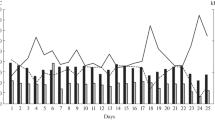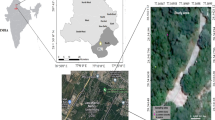Abstract
The genus Aquilaria (Thymelaeaceae) is widely used for the production of agarwood, and includes several valuable plantation species in Southeast Asia. To understand appropriate planting conditions, it is necessary to characterize species-specific ecological traits such as photosynthesis and drought tolerance among Aquilaria species. To this end, we measured leaf morphological and photosynthetic traits among three Aquilaria seedlings (A. hirta, A. malaccensis, A. subintegra) in Malaysia. We also monitored changes in growth and survival in a shaded nursery and 7 and 18 months after transfer to open conditions. To avoid transplant stress, the seedlings were kept in polybags. The highest leaf cuticle and epidermis layer ratio, leaf mass per area, and long-term water use efficiency indicated by δ13C were recorded in A. hirta, suggesting that this species had relatively high drought tolerance. By contrast, the high maximum photosynthetic rate and high stomatal conductance observed in A. subintegra explained their high growth rate, although their drought tolerance was the lowest among the studied species. A. malaccensis was considered an intermediate species in terms of photosynthesis and drought tolerance. Interspecific differences in growth and survival were present after transfer to open conditions. A. hirta had the lowest growth rate and highest survival rate (50% survival after 18 months), whereas A. subintegra had the highest growth rate and lowest survival rate (9% survival after 18 months). A. malaccensis was intermediate between the two. In summary, the studied Aquilaria species were susceptible to stress under the open and dry conditions of our study. This includes Aquilaria hirta, the most drought-tolerant species in this group, and A. subintegra, the most vulnerable species to drought, which may require careful management when planted in open conditions.



Similar content being viewed by others
References
Appanah S, Weinland G (1993) Planting quality timber trees in peninsular Malaysia. A review. Malayan forest records no. 38, FRIM, Kuala Lumpur
Ashton PMS, Berlyn GP (1992) Leaf adaptations of some Shorea species to sun and shade. New Phytol 121:587–596
Boote KJ, Loomis RS (1991) The prediction of canopy assimilation. In: Boote KJ, Loomis RS (eds) Modeling crop photosynthesis: from biochemistry to canopy. Crop Science Society of America, Madison, pp 109–140
Burslem DFRP (1996) Differential responses to nutrients, shade and drought among tree seedlings of lowland tropical forest in Singapore. In: Swaine MD (ed) The ecology of tropical forest tree seedlings. UNESCO, Paris, and Parthenon, Carnforth, UK, pp 109–139
Camilo-Alves CSP, Vaz M, Da Clara MIE, Ribeiro NMDA (2017) Chronic cork oak decline and water status: new insights. New For 48:753–772
Donovan D, Puri R (2004) Learning from traditional knowledge of non-timber forest products: Penan Benalui and the autecology of Aquilaria in Indonesian Borneo. Ecol Soc 9: article number 3
Ehleringer JR, Field CB, Lin ZF, Kuo CY (1986) Leaf carbon isotope and mineral composition in subtropical plants along an irradiance cline. Oecologia 70:520–526
Mustafa NMSN, Emori, K., Hoe AL., Kamaruzaman MP, Hwai YY (2002) Forest plantation for the future -A record of the multi-storied forest management project in Malaysia and the small scale fast-growing forest plantation project in Malaysia. Forestry Department Peninsula Malaysia, Perak State Forestry Department, Japan International Cooperation Agency, Kuala Lumpur
Evans JR (1989) Photosynthesis and nitrogen relationships in leaves of C3 plants. Oecologia 78:9–19
Farida-Hanum I, Mustapa MZ, Lepun P, Tuan TI, Nazre MM, Alan R, Mohamed R (2009) Notes on the distribution and ecology of Aquilaria Lam. (Thymelaeaceae) in Malaysia. Malay For 72:247–259
Farquhar GD, Hubick KT, Coudon AG, Richards RA (1989) Carbon isotope fractionation and plant water-use efficiency. In: Rundel PW, Ehleringer JR, Nagy KA (eds) Stable isotopes in ecological research. Springer, Heidelberg, pp 21–40
Givnish TJ (1984) Leaf and canopy adaptations in tropical forests. In: Medina E, Mooney HA, Vázquez-Yanes C (eds) Physiological ecology of plants of the wet tropics. Junk, The Hague, pp 51–84
Hodecker BER, Pita-Barbosa A, de Barros NF, Merchant A (2018) Water availability preceding long-term drought defines the tolerance of Eucalyptus to water restriction. New For 49:173–195
Hou D (1960) Thymelaeaceae. Flora Malesiana 6:1–59
Ichie T, Inoue Y, Takahashi N, Kamiya K, Kenzo T (2016) Ecological distribution of leaf stomata and trichomes among tree species in a Malaysian lowland tropical rain forest. J Plant Res 129:625–635
Inoue Y, Kenzo T, Tanaka-Oda A, Yoneyama A, Ichie T (2015) Leaf water use in heterobaric and homobaric leafed canopy tree species in a Malaysian tropical rain forest. Photosynthetica 53:177–186
Irino KO, Kang Y, Kenzo T, Hattori D, Ishizuka S, Ninomiya I, Iwasaki K, Kendawang JJ, Sakurai K (2005) Performance of pot-grown seedlings of the dipterocarp Dryobalanops lanceolata with controlled-release fertilizer after transplantation to the shifting cultivation land in Sarawak, Malaysia. Soil Sci Plant Nutr 51:369–377
Ishida A, Nakano T, Matsumoto Y, Sakoda M, Ang LH (1999) Diurnal changes in leaf gas exchange and chlorophyll fluorescence in tropical tree species with contrasting light requirements. Ecol Res 14:77–88
Ishizuka S, Tanaka S, Sakurai K, Hirai H, Hirotani H, Ogino K, Lee HS, Kendawang JJ (1998) Characterization and distribution of soils at Lambir Hills National Park in Sarawak, Malaysia, with special reference to soil hardness and soil textures. Tropics 8:31–44
Kenzo T, Ichie T, Ozawa T, Kashimura S, Hattori D, Irino KO, Kendawang JJ, Sakurai K, Ninomiya I (2007a) Leaf physiological and morphological responses of seven dipterocarp seedlings to degraded forest environments in Sarawak, Malaysia: a case study of forest rehabilitation practice. Tropics 17:1–16
Kenzo T, Ichie T, Watanabe Y, Hiromi T (2007b) Ecological distribution of homobaric and heterobaric leaves in tree species of Malaysian lowland tropical rainforest. Am J Bot 94:764–775
Kenzo T, Yoneda R, Azani MA, Majid NM (2008) Changes in leaf water use after removal of leaf lower surface hairs on Mallotus macrostachyus (Euphorbiaceae) in a tropical secondary forest in Malaysia. J For Res 13:137–142
Kenzo T, Yoneda R, Matsumoto Y, Azani MA, Majid NM (2011) Growth and photosynthetic response of four Malaysian indigenous tree species under different light conditions. J Trop For Sci 23:271–281
Kenzo T, Inoue Y, Yoshimura M, Yamashita M, Tanaka-Oda A, Ichie T (2015) Height-related changes in leaf photosynthetic traits in diverse Bornean tropical rain forest trees. Oecologia 177:191–202
Kenzo T, Iida SI, Shimizu T, Tamai K, Kabeya N, Shimizu A, Chann S (2016) Seasonal and height-related changes in leaf morphological and photosynthetic traits of two dipterocarp species in a dry deciduous forest in Cambodia. Plant Ecol Divers 9:505–520
Kramer PJ, Boyer JS (1995) Water relations of plant and soils. Academic Press, San Diego
LaFrankie JV (1994) Population dynamics of some tropical trees that yield non-timber forest products. Economic Bot 48:301–309
Lee SY, Mohamed R (2016) The origin and domestication of Aquilaria, an important agarwood-producing genus. In: Mohamed R (ed) Agarwood. Springer, Singapore, pp 1–20
Lee DW, Oberbauer SF, Krishnapilay B, Mansor M, Mohamad H, Yap SK (1997) Effects of irradiance and spectral quality on seedling development of two Southeast Asian Hopea species. Oecologia 110:1–9
Lee HS, Ashton PS, Yamakura T, Tan S, Davies SJ, Itoh A, Chai EOK, Ohkubo T, LaFrankie JV (2002) The 52-hectare forest research plot at Lambir Hills, Sarawak, Malaysia: tree distribution maps, diameter tables and species documentation. Forest Department of Sarawak, Kuching
Lok EH, Zuhaidi AY (1996) The growth performance of plantation grown Aquilaria malaccensis in peninsular Malaysia. J Trop For Sci 8:573–575
Lok EH, Shyun CY, Yusoff AM (1999) Early survival and growth in field trials of Aquilaria malaccensis (Karas) and Azadirachta excelsa (Sentang). J Trop For Sci 11:852–854
López-Sampson A, Page T (2018) History of use and trade of agarwood. Economic Bot 72:107–129
López-Sampson A, Cernusak LA, Page T (2017) Relationship between leaf functional traits and productivity in Aquilaria crassna (Thymelaeaceae) plantations: a tool to aid in the early selection of high-yielding trees. Tree Physiol 37:645–653
Newton AC, Soehartono T (2001) CITES and the conservation of tree species: the case of Aquilaria in Indonesia. Int For Rev 3:27–33
Ng LT, Chang YS, Kadir AA (1997) A review on agar (gaharu) producing Aquilaria species. J Trop Forest Prod 2:272–285
Okajima Y, Taneda H, Noguchi K, Terashima I (2012) Optimum leaf size predicted by a novel leaf energy balance model incorporating dependencies of photosynthesis on light and temperature. Ecol Res 27:333–346
Oliet JA, Blasco R, Valenzuela P, de Blas MM, Puértolas J (2018) Should we use meshes or solid tube shelters when planting in Mediterranean semiarid environments? New For. https://doi.org/10.1007/s11056-018-9659-z
Oyen LPA, Dung NX (1999) Plant resource of South-East Asia. No19 Essential-oil plants. Backhuys Publishers, Leiden
Page T, Awarau W (2012) Performance of agarwood (Aquilaria crassna) seedling transplants improved by shade and fertiliser. For Ecol Manag 265:258–269
Paoli GD, Peart DR, Leighton M, Samsoedin I (2001) An ecological and economic assessment of the nontimber forest product gaharu wood in Gunung Palung National Park, West Kalimantan, Indonesia. Conserv Biol 15:1721–1732
Pattison RR, Goldstein G, Ares A (1998) Growth, biomass allocation and photosynthesis of invasive and native Hawaiian rainforest species. Oecologia 117:449–459
Peterson B (1997) Thymelaeaceae. Flora Thail 6:226–245
Poorter H, Niinemets Ü, Poorter L, Wright IJ, Villar R (2009) Causes and consequences of variation in leaf mass per area (LMA): a meta-analysis. New Phytol 182:565–588
Rashid AM, Zuhaidi AY (2011) Tapping the wealth from Karas (Aquilaria malaccensis) tree. Malayan Forest Records No. 50, FRIM, Kuala Lumpur
Ryan MG, Phillips N, Bond BJ (2006) The hydraulic limitation hypothesis revisited. Plant Cell Environ 29:367–381
Saikia P, Khan ML (2012) Seedling survival and growth of Aquilaria malaccensis in different microclimatic conditions of northeast India. J For Res 23:569–574
Sansevero JBB, Prieto PV, Sánchez-Tapia A, Braga JMA, Rodrigues PJFP (2017) Past land-use and ecological resilience in a lowland Brazilian Atlantic Forest: implications for passive restoration. New For 48:573–586
Soehartono T, Newton AC (2001) Conservation and sustainable use of tropical trees in the genus Aquilaria II. The impact of gaharu harvesting in Indonesia. Biol Conserv 97:29–41
Soehartono T, Newton AC (2002) The gaharu trade in Indonesia: Is it sustainable? Economic Bot 56:271–284
Soehartono T, Newton AC, Mardiastuti A (2002) Factors influencing the survival and growth of Aquilaria malaccensis seedlings in Indonesia. J Trop For Sci 14:364–378
Tanaka-Oda A, Kenzo T, Koretsune S, Sasaki H, Fukuda K (2010) Ontogenetic changes in water-use efficiency (δ 13C) and leaf traits differ among tree species growing in a semiarid region of the Loess Plateau, China. For Ecol Manag 259:953–957
Terashima I, Hikosaka K (1995) Comparative ecophysiology of leaf and canopy photosynthesis. Plant Cell Environ 18:1111–1128
Turner IM (2001) The ecology of trees in the tropical rain forest. Cambridge University Press, Cambridge
Whitmore TC (1972) Tree flora of Malaya, vol 2. Longman, London
Yamada I (1995) Aloeswood forest and the maritime world. Southeast Asian Stud 33:181–186
Yoneda R, Matsumoto Y, Kenzo T, Alias MA, Majid NM (2005) The short-term gas exchange and photoinhibition responses in planted Dyera costulata seedlings under artificial shading shelter in open condition. Jpn J For Environ 47:113–118
Zotz G, Winter K (1993) Short-term photosynthesis measurements predict leaf carbon balance in tropical rain-forest canopy plants. Planta 191:409–412
Acknowledgements
We thank staffs and students in Universiti Putra Malaysia and Ms. Futaba T for their assistance in our study. This work was partly supported by a Grant-in-Aid for Scientific Research (24688017 and 16K07795) from the Ministry of Education, Science and Culture, Japan.
Author information
Authors and Affiliations
Corresponding author
Rights and permissions
About this article
Cite this article
Kenzo, T., Yoneda, R., Tanaka-Oda, A. et al. Growth performance and leaf ecophysiological traits in three Aquilaria species in Malaysia. New Forests 50, 699–715 (2019). https://doi.org/10.1007/s11056-018-09693-7
Received:
Accepted:
Published:
Issue Date:
DOI: https://doi.org/10.1007/s11056-018-09693-7






